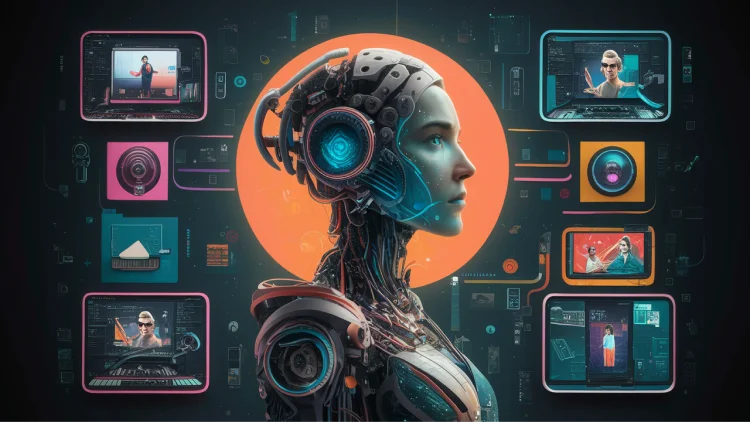AI is among us, and it turns out it has been, in one form or another, for quite some time. It’s only been very recently that it’s become so pervasive, and so advanced, that it’s come fully into the public eye.
The AI snowball is now thundering down the hill. How did it pick up so much momentum so fast?
And of all the potential it represents, how can it help your business on Amazon?
The AI Timeline
It’s instinctive to see an exciting new thing and immediately wonder how it can be applied to one’s own chosen endeavor.
We’re Amazon sellers. Naturally, once AI started making the big headlines, at least part of our thinking went pretty quickly to our own entrepreneurial game:
“Ooh,” the lightbulb flickered, our eyebrows rising. “How can this make the things I do on Amazon easier/better/faster?”
The short answer: lots of ways. Listing optimization is the most obvious, and the one we’ll talk about here.
Let’s first take a look at a few major milestones in artificial intelligence.
- 1956 | The term “Artificial Intelligence” is introduced.
- 1964 | The first chatbot capable of holding a rudimentary conversation with a human is tested.
- 1997 | IBM’s Deep Blue defeats the world chess champion.
- 1999 | Sony launches the first robot pet dog, AIBO, capable of evolving skills.
- 2002 | The Roomba, able to learn to navigate homes, hits the market.
- 2011 | Apple’s virtual assistant, Siri, is introduced.
- 2014 | Amazon’s virtual assistant, Alexa, is launched.
- 2020 | GPT-3 tool for automated conversations is introduced.
- 2022 | ChatGPT is made available for public testing.
That’s about when the current AI sensation kicked off. Since then the snowball has been rolling fast.
Question is, now that AI is in wider and more public use, how is it stacking up?
What’s Gone Wrong (With AI)
When it comes to “good news-bad news” we believe in covering the cautionary stuff first, so we’ll start there.
There’s definitely good news when it comes to AI.
Note: In this article we’re talking primarily about using AI for Amazon listings, and how the “generative” part of AI can help create and optimize them. Generative being the “G” in the most popular example, ChatGPT.
Generative Pre-trained Transformer (GPT) is the full breakdown of that term.
It’s worth a few more seconds reviewing the significance of that G.
Today’s crop of AI is all “generative”. Generative AI churns out human-like text by predicting the next word in a sentence based on the words that came before it.
Meaning generative AI is not actually intelligent.
The actually intelligent AI is called Artificial General Intelligence (AGI), and such technology has “autonomous self-control, a reasonable degree of self-understanding, and the ability to learn new skills”.
AGI would be able to solve complex problems in settings and contexts that were not taught to it at the time of its creation.
To date it doesn’t exist.
Meaning … what? The GPT stuff isn’t literally smart?
It isn’t, but it can sure as heck seem that way – which is where the problems begin. Generative AI is just a product of an enormous volume of data and a few very clever algorithms (written by programmers).
Which means, lacking actual judgment and understanding, or acting on flawed data, errors can, and do, occur.
Glitches In The Machine
No matter how whiz-bang impressive, how wow-inducing, how OMG how does it do that, at this stage of the game AI comes down to one, single, solitary – yet important – value-add:
It saves time.
No matter how fancy the results, it can’t do anything a human can’t do.
Mainly because that’s all it has been built to do: copy humans.
The sheer volume and variety of human stuff generative AI has at its disposal can make that copying end up unique, occasionally bizarre, and sometimes flawed.
Which is where most of the trouble begins.

Check Your Work
AI can now do so much, so fast, and creates results so effortlessly, that we often miss the errors. AI is a timesaver, yes, but it needs to be checked, proofed, or otherwise reviewed before it’s ready to share.
If you’re using it to help generate listings, or elements of your listings, such as text, video or images (if you didn’t already know, AI can also generate video – see sections below) always check the results.
With AI as good as it is today, it’s easy to think you can just give it some inputs, turn it loose for a few minutes (or a few seconds), get an amazing result, put that result immediately into use and be on to your next project.
You can’t. Or, rather, you probably shouldn’t. Always make time to give any AI generated material a cross-check before deploying.
You’ll still be saving tons of time and energy, plus you won’t have to fix an easy mistake later.
That said, AI’s come a long way. Despite any flaws, it can be a huge benefit to your business operations.
What’s Gone Right (With AI)
Generative AI has advanced to the point it’s no longer a question of whether to begin employing it as a resource, but how quickly, where in your business, and to what degree.
Acting as content creator is one of its greatest strengths. Initially that was text, in the form of turning out written content based on user instructions (called prompts; the task commands you give AI), but it has since evolved to include images and videos.
Yes, there are even products now that can turn out high-quality videos.
Tools currently on the market can easily be put to use in the creation and optimization of Amazon listings. Amazon listings are all about generating content, which these days includes images and video; adding such AI options to your existing suite has the potential to greatly increase your efficiency, and to achieve the ultimate benefit of AI: saving you time.
AI has indeed found its way into many, many products, and is increasingly part of the things we use every day.
For content generation, certain examples stand out.
Some Of The Hottest Tools Right Now
Each day, it seems, more options become available or existing offerings are improved.
Our “hot pick” for each category is as follows.
Text Generation
This is kind of where it all started, and they’re still the hottest game in town. In fact, of all the offerings now available, ChatGPT continues to rule the roost.
What makes ChatGPT especially unique is the use of what’s called Reinforcement Learning from Human Feedback (RLHF) to train it. Human AI trainers provide the model with conversations in which they play both parts, the user and the AI assistant, bringing the results yet closer to human-seeming interaction.
Image Generation
DALL-E 2 (also part of the OpenAI project, like ChatGPT), has been doing this the longest and, if you’re using ChatGPT for text generation, DALL-E would be a perfect fit for your image needs.
Note there’s also now a DALL-E 3, released a few months ago in November.

Video Generation
A generator called Pika has been making waves. From humble beginnings (where a lot of groundbreaking software begins, it seems) to a tool that quite literally puts ideas in motion, this one is worth checking out.
In their own words:
“Pika was founded by two Stanford Ph.D students who felt making videos was too damn hard. So, they decided to make it easier for anyone to create video on command.”
With a tagline of “We’re for anyone with an imagination,” it’s hard not to be intrigued by the possibilities.
The option to create videos in this way opens the playing field to anyone and everyone, making it a game changer.
Voice Generation
Video generation is amazing, but voice generation (text to believable voice) gives it a run for the money.
Our choice for this category is ElevenLabs, and if you’re looking to add a spoken component to any of your content, this one works.
Fun tidbit, if you go to the site link above, there’s a sample speech generator you can play with. Our favorite is Clyde.
The Horse’s Mouth
And, unsurprisingly, Amazon has an offering of its own, which they’ve been improving.
They started by allowing sellers to provide a few words that described their product, then used generative AI to create product titles, descriptions, and other product details.
Next they added the ability for sellers to simply upload an image of their product and AI would generate their product title, description, and even more product attributes. Including suggesting attributes such as color and keywords to help effectively index the product in customer search experiences.
Pretty cool, if you didn’t know Amazon could do that.
Now, in addition to using provided text prompts or an image to generate listings, you can send the Amazon AI to your company site. Give it the URL and it will parse the product info there and create listings.
In each case, as with any tool, the application determines the advantage.

Pros & Cons
How you apply the content generated is as important as the content itself.
Specific to listing optimization, there are pros and cons, though most issues with using AI come from a failure to cross-check results. (See What’s Gone Wrong section above.)
Cons
Cons with AI end up being more cautionary tales than actual drawbacks.
There isn’t really a “do not use” scenario when it comes to using AI for your listings, more that you need to always check your work, as mentioned above.
Funny – though also kind of sad – examples exist of sellers seemingly dropping an AI bomb on their listings, yelling “fire in the hole!” and running for cover.
Those situations should never materialize.
Checking and reviewing your AI content is imperative. It does add an extra step, but the (often huge) amount of time saved by having AI generate the first draft of what will become your Amazon listing is worth a bit of clean-up.
More and more AI results are close to perfect right out of the gate, but nothing beats a human perspective to thoroughly vet any content it creates.
Pros
The main advantage of AI is time savings, but it can fill other roles.
AI can also act as:
- A teacher. You may be a new seller, lacking experience, in which case AI can act as a guide and a quick start to crafting your listing.
- An idea generator. AI can draw from, literally, the sum of info available on the internet. It’s possible it will identify some product benefit you hadn’t thought of.
- A translator. An obvious aid, if you’re writing in English, for example, but that’s not your primary language; AI can help craft better copy.
Plus if you’re a large Amazon seller, AI can help you handle a high volume of listings in order to manage and grow your business.
Recently, one of the biggest advantages of AI has to do with Amazon itself.
Common Sense Knowledge Generation
A new system underpinning Amazon’s AI search will soon reshape how we all shop by understanding customer behavior and intent behind the search.
Called COSMO, a “Common Sense Knowledge Generation” system, this new push by Amazon is further evidence that the AI train has not only left the station, but that if you’re not on it you’ll soon be walking.
COSMO is Amazon’s latest application of AI; yet more indication that this is where the future is headed.
The new AI engine sits behind the scenes and determines customer intent. It operates with a “human-like common sense” that understands and predicts customers’ present and future interests and links intent to products.
Meaning sellers – and their listings – need to feed the algorithms powering this. Best way to do that is with product listings optimized within an inch of their life.
Best way to do that?
With the sort of thorough insight AI can provide. It’s almost like fighting AI with AI, you might say. Or using AI to keep up with AI.
Our own Vanessa Hung, Cofounder of SellerAssist by Carbon6, talks about this in an insightful LinkedIn post.
Predictions
Given that Amazon is developing its own AI tools at a steady pace, it would be safe to predict that using AI to craft listings will continue to be not only an expected part of your overall strategy, but encouraged.
Based on the many indications available, it would seem a safe bet that Amazon will reward sellers using AI to optimize their listing content with higher quality customer traffic, and more of it.
This will most likely be especially true of those using Amazon’s own listing generation tool.
As AI becomes increasingly able to “understand” customer search intent and thus perfect the shopping experience, the result will be higher conversions and, the follow-on to those more perfectly targeted search results, greater sales.
Carbon6 tools and services, such as our new SellerAssist by Carbon6 Seller Central account management offering, exist to help you maximize these opportunities. We’re standing by to put our knowledge and experience to work for you.
Conclusion
When it comes to selling on Amazon, success depends on many factors, two of the most important being:
- Effectiveness, and
- Speed.
AI is getting better each day at delivering both. Your decisions, when it comes to using this incredible technology, can both tighten and accelerate your operations.
AI is no longer the Future, is it the Now.




